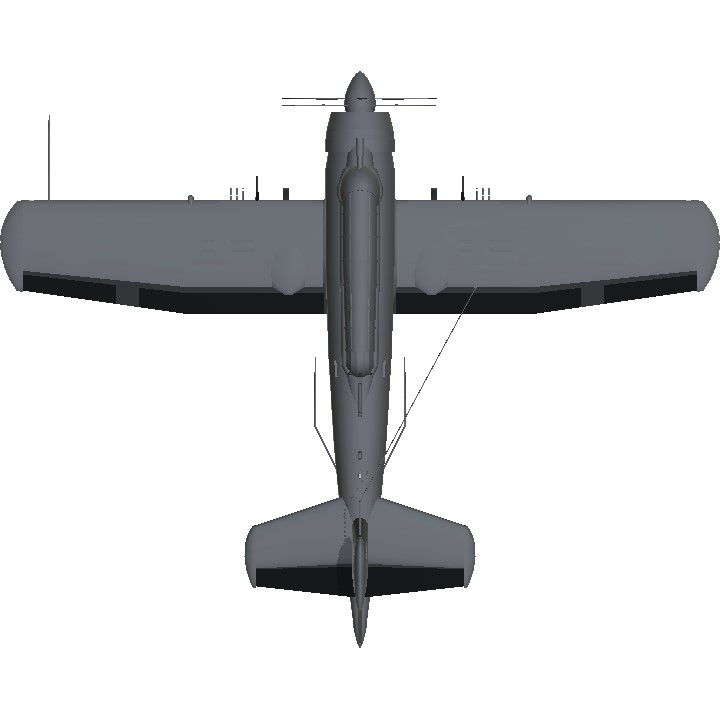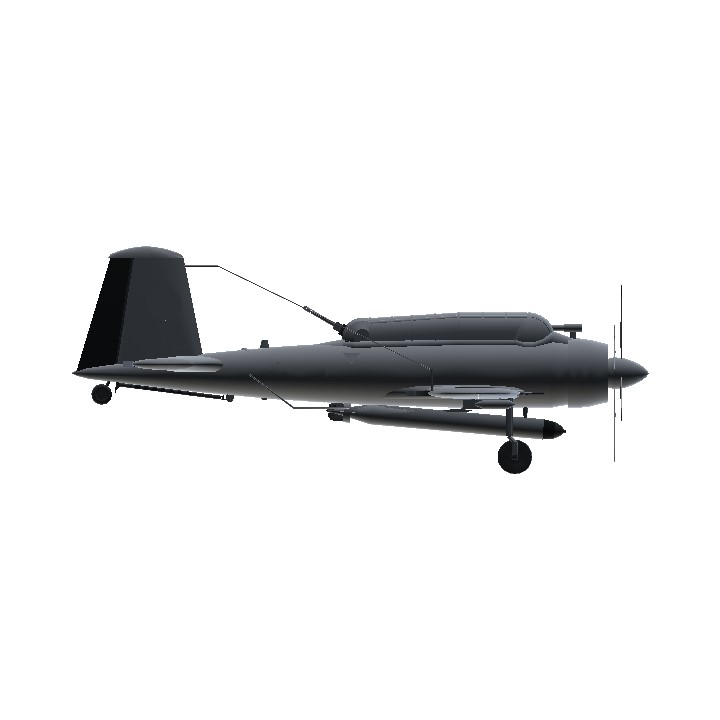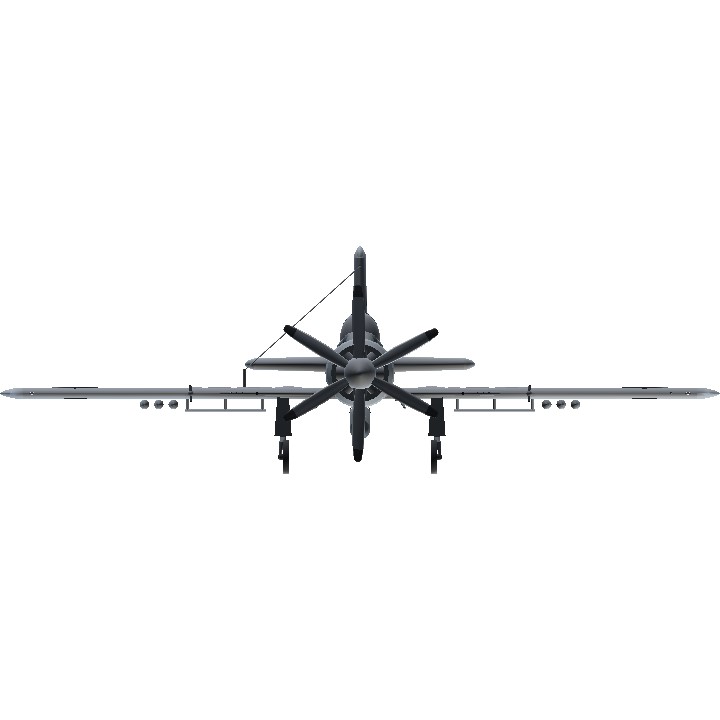[ DECLASSIFIED SEPTEMBER 29, 2024 ]
[ C L A S S I F I E D D H C D O C U M E N T ]
O-20 Eisensoldat / B9F "Wendy"
After investigating documents given by the Japanese Air Force to the company by eaely 2020, it is concluded that the M-23 Richtofen had a Japanese-based successor that founders [REDACTED] and [REDACTED] planned by the late 1943. The aforementioned documents were preserved and kept confidential by Japan from the rest of the world. It is designated as the O-20, an aircraft that had its parts transported across the Eurasian continent to be built Japan and served in World War II's Pacific theater.
DESCRIPTION
Introduction
The M-23 is a heavy multirole fighter aircraft designed by the founder and co-founder of the DHC as a prototype that would serve the Imperial Japanese Navy in the Pacific as a heavily-revised version and supposed replacement of Nakajima's B5N aircraft, which was becoming more and more obsolete as the war dragged on.
Document I: Design

An O-20 Eisensoldat peacefully flying solo, clear noon of early 1945
By late 1944, Nazi Germany had handed out another contract for another aircraft to be transported across Eurasia to supplement Japan's late war defense against the Americans. Sadly, all of Luftwaffe's German aircraft companies still denied the contract to make room for building new aircraft or improve their current aircraft. Fortunately, Dunkelhundkonzern accepted the contract again. Using the money they earned from producing the L-84, Dunkelhundkonzern borrowed blueprints from Nakajima and took off to improve the B5N "Kate." The overall design was from the B5N, but the aircraft is longer by its length and had a wider wingspan. The canopy design is revised, with the front end for the pilot revised to a spherical shape to increase the pilot's viewing range. The wing placement is maintained from the L-84, however the angle is made completely straight to lower both centers of mass and lift for more landing stability. Dunkelhundkonzern used the same AD-294Z radial engine for the O-20 due to being revealed to be very powerful from their prototypes of the M-23, changing the aircraft cowling to fit the large size of the engine. When fully loaded with fuel and weapon payloads, the aircraft rivaled its predecessor named J-62K Kampffritzer, reaching up to around 18,800lbs in weight. Dunkelhundkonzern also took the Jericho Trumpet from the Ju-87 Stuka, and also added additional flaps below the wing. Since the aircraft was expected to serve at open sea on aircraft carriers, a carrier landing hook was mandatory to apply. Wing folding mechanisms were also applied to help save space on carrier hangars.
Document II: Armament

An O-20 flying low over a sinking American destroyer, night of early 1945
The aircraft was mounted with six machine guns, with three for each wing. These guns and their configuration are taken from the M-23. Its payload capability was a larger feat than the M-23, as the aircraft was capable of carrying a 2000lb payload with around 35 miles per hour removed from its top speed.
Document III: Performance Report

An O-20 dropping its six SC50 bombs in a divebomb test run, foggy afternoon of early 1945
The aircraft was around the same speed as the L-84 at 340 miles per hour at sea level top speed test runs. But its roll response was slower than its predecessor, rendering its maneuverability to be reminescent of that of a typical light bomber. Being slightly larger than the B5N and along with its powerful engine, it was around 100 miles per hour faster than the original B5N at around 13,000 feet. The aircraft is to reach a top speed of around 340 miles per hour at sea level, way slower than the M-23. However, in numerous prototype flights it is said to reach up to around 430 miles per hour when full throttle nosedives were performed. The aircraft is more easier to take off and is slightly easier to land than the M-23.
1945 Imperial Japanese Navy Report

An O-20 leaving the scene of a sinking escort carrier, hazy sunset of early 1945
The O-20 was transported as parts across Eurasia in four separate convoys of thirty cargo trucks, but one of the convoys were spotted by Allied aircraft and bombed repeatedly. After the aerial raids, only nine trucks survived from the attacked convoy. Despite the loss of potential units, it was approved by the Imperial Japanese Navy for its durability that was higher than the original Nakajima-produced model. It was also praised for its higher speed, larger payload and divebombing capabilities, making it a perfect Allied fleet strafer. It was also agile enough to be able to escape the F6F Hellcats of the US, but its low maneuverability hindered its capabilities in high speed dogfights. The aircraft sadly only produced 3 prototypes and 17 active units, due to extensive Allied bombings on Japan's aircraft factories and loss of resources. The aircraft was used only as suicide aircraft, and never had actual active participation in the war. Only three units survived the war, as the other fourteen units were shot down by Allied aircraft or used in kamikaze missions.
SPECIFICATIONS
Top speed: up to 340 miles per hour at 1000 feet
Service ceiling: around 27,000 feet
Cruise speed: around 300 miles per hour at service ceiling
Crew: 4: pilot, navigator, torpedo bomber, gunner
Fuel Capacity: 966 gallons
ARMAMENT
The armament carried by the aircraft is listed below:
- 6x DHC K92A Machine Guns
- 2x DHC D-28SS Maximilian Cannons
- 1x DHC K93J Machine Gun [Turret]
- 1x Type 91 Torpedo
- 6x Herman SC50 GP Bombs
CONTROLS
The full controls and camera list for the aircraft is listed below:
- VTOL : Flaps
- AG1 : Toggle Navigation Lights
- AG2 : N/A
- AG3 : Toggle Wing Guns
- AG4 : Toggle Autopilot and Turret Controls
- AG5 : Toggle Carrier Landing Hook
- AG6 : Toggle Wing Fold
- AG7 : N/A
- AG8 : N/A
- AG4 + Pitch/Roll : Turret Controls
- AG4 + Fire Guns : Fire Turret Gun
- AG3 + Fire Guns : Fire Main Guns
- Brake : Activate Airbrakes and Divebombing Sirens
- Cam1 : Propeller
- Cam2 : Gunner Turret
- Cam3 : Torpedo
- Cam4 : Wing Guns
- Cam5 : Divebombing Bombsight
- Cam5 + Brake : Zoom In
CAUTION
Only activate the autopilot when flying between -10° to 10°, activating autopilot at any angle beyond said range might destroy the propellers or result to stalling the aircraft.
Addendum Number 83:
Divebomb Procedures
- Approach enemy ground target from an altitude of around 10,000 to 20,000 feet
- Once directly above target, cut off power and roll 180°
- Quickly pull flaps all the way down and engage divebrakes
- Go to Cam5 and aim
- Use roll and pitch to change bomb trajectory
- Once at around 2,000 feet, jettison all SC50 bombs
- If necessary, you can also jettison the Type 91 torpedo
- After releasing all bombs, let go of airbrakes, push throttle to the maximum, and pull up
- If target has AA weapons, perform evasive maneuvers while waiting for bombs to destroy ground target
[ C L A S S I F I E D D H C D O C U M E N T ]
Big thanks to:
- Quackie for the SC50 bombs from his bomb set
- masotan15 for the idea of the autopilot gyroscope and Jericho Trumpets from his JU-87 Stuka
[ DECLASSIFIED SEPTEMBER 29, 2024 ]
Specifications
Spotlights
- Quackie 5.6 years ago
- Bernkastel 5.5 years ago
- Boelin 5.6 years ago
General Characteristics
- Created On Android
- Wingspan 51.1ft (15.6m)
- Length 41.0ft (12.5m)
- Height 16.2ft (4.9m)
- Empty Weight 13,051lbs (5,920kg)
- Loaded Weight 19,533lbs (8,860kg)
Performance
- Horse Power/Weight Ratio 0.461
- Wing Loading 22.5lbs/ft2 (109.8kg/m2)
- Wing Area 868.5ft2 (80.7m2)
- Drag Points 8320
Parts
- Number of Parts 320
- Control Surfaces 17
- Performance Cost 1,311







@MBR6753
@Quackie
@masotan15